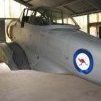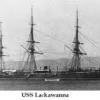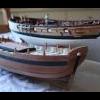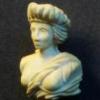MORE HANDBOOKS ARE ON THEIR WAY! We will let you know when they get here.
×
-
Posts
1,197 -
Joined
-
Last visited
Reputation Activity
-
 Stuntflyer got a reaction from wyz in HM Cutter Cheerful 1806 by Stuntflyer (Mike) - FINISHED - 1:48 scale
Stuntflyer got a reaction from wyz in HM Cutter Cheerful 1806 by Stuntflyer (Mike) - FINISHED - 1:48 scale
Thanks guys!
Erik - Thanks for the feedback. I know that there are many different methods out there, some being better than mine, for sure. Still, I really enjoy sharing these things with other modelers.
Bob - I plan on doing the curved planking. I hope you're right about it not being too difficult.
Mike
-
 Stuntflyer got a reaction from PeteB in HM Cutter Cheerful 1806 by Stuntflyer (Mike) - FINISHED - 1:48 scale
Stuntflyer got a reaction from PeteB in HM Cutter Cheerful 1806 by Stuntflyer (Mike) - FINISHED - 1:48 scale
Planking the deck is not exactly what I would call a milestone though it does feel like I'm moving along. . .
Though not very scientific, I did come up with a way to get those center planks in a straight line. After setting the first plank at the stern I used a card template at each location along the deck to keep the planks straight. To confirm alignment, I marked the center of the plank at its forward edge as well as the aft edge of the deck structure. After pulling the plank to the card template I could see whether or not two marks matched closely
The four remaining planks (two on each side of center plank) where then installed using PVA and clamps. I was careful not to glue anywhere close to the red deck structures. Scrap strips were used between the clamp and the deck planking to avoid any dents that might be caused from tightening of the clamps. I don't have any of those high-tech wooden clamps like those used by EdT though the ones from Dewalt (found at Home Depot) worked well enough. The clamp's protective covers were removed in order to get a better grip on the planks. The Irwin Quick-Grips have a more rounded shape underneath the covers and tend to slip off too easily.
My deck planks are approximately 3/16" wide and in various locations will have a small tab. These have to be made using a wider strip. I tried making one that would have been 7/32" at its widest point using a 7/32" strip. Guess what, it didn't work. There wasn't enough room to allow for adjustments to the shape. I decided to go with a 1/4" strip, which worked quite well. Once the shape was completed it was only a matter of reducing the width to 3/16" outside of the tab location. This is an important step if you want to maintain consistency to the overall look of the planking.
This is the plank which goes on either side of the "ventilation scuttle grating", just behind the skylight.
Once the first five rows were completed, excess glue was removed and the planks were lightly sanded. I will hold off doing the final sanding until all of the remaining planks are in.
-
 Stuntflyer got a reaction from mtaylor in HM Cutter Cheerful 1806 by Erik W - 1:48 scale
Stuntflyer got a reaction from mtaylor in HM Cutter Cheerful 1806 by Erik W - 1:48 scale
Looks really good!
Mike
-
 Stuntflyer reacted to Erik W in HM Cutter Cheerful 1806 by Erik W - 1:48 scale
Stuntflyer reacted to Erik W in HM Cutter Cheerful 1806 by Erik W - 1:48 scale
Mike,
Thanks! I did hold the batten strip down in several areas. The run is smooth, and it lays flat on all the bulkheads. I'm waiting to tack it down until I do the other side. I know I need to remove a little more material at the bow. I'll wait to tweak the bow area when I have both sides faired. That way I can make sure both sides are symmetrical. I'm a little paranoid about removing too much material, so I'll really go over everything meticulously after the gun ports are framed, and I do that final fairing.
Erik
-
 Stuntflyer got a reaction from Canute in HM Cutter Cheerful 1806 by Erik W - 1:48 scale
Stuntflyer got a reaction from Canute in HM Cutter Cheerful 1806 by Erik W - 1:48 scale
Looks really good!
Mike
-
 Stuntflyer reacted to Erik W in HM Cutter Cheerful 1806 by Erik W - 1:48 scale
Stuntflyer reacted to Erik W in HM Cutter Cheerful 1806 by Erik W - 1:48 scale
I did the first rough fairing of one half of the Cheerful hull. There are a couple spots that need more work. I'll touch those up when I do the final fairing after framing the gun ports. It was quite an undertaking compared to fairing the much smaller longboat. Sanding the 5-ply plywood that constitutes the bulkheads makes for some slow sanding! After initial material removal with a 60 grit sanding block, I did wind up mainly using the 7" long flexible nail files that are 120 grit. I also made a sanding block out of a 1" dowel with 150 grit sandpaper glued to it to sand the concave rear part of the hull. The two curved sanding blocks I made I didn't wind up using. The flexible nail files did a better job. Now . . . on to the other side . . .
Erik
-
 Stuntflyer got a reaction from GuntherMT in HM Cutter Cheerful 1806 by Stuntflyer (Mike) - FINISHED - 1:48 scale
Stuntflyer got a reaction from GuntherMT in HM Cutter Cheerful 1806 by Stuntflyer (Mike) - FINISHED - 1:48 scale
Planking the deck is not exactly what I would call a milestone though it does feel like I'm moving along. . .
Though not very scientific, I did come up with a way to get those center planks in a straight line. After setting the first plank at the stern I used a card template at each location along the deck to keep the planks straight. To confirm alignment, I marked the center of the plank at its forward edge as well as the aft edge of the deck structure. After pulling the plank to the card template I could see whether or not two marks matched closely
The four remaining planks (two on each side of center plank) where then installed using PVA and clamps. I was careful not to glue anywhere close to the red deck structures. Scrap strips were used between the clamp and the deck planking to avoid any dents that might be caused from tightening of the clamps. I don't have any of those high-tech wooden clamps like those used by EdT though the ones from Dewalt (found at Home Depot) worked well enough. The clamp's protective covers were removed in order to get a better grip on the planks. The Irwin Quick-Grips have a more rounded shape underneath the covers and tend to slip off too easily.
My deck planks are approximately 3/16" wide and in various locations will have a small tab. These have to be made using a wider strip. I tried making one that would have been 7/32" at its widest point using a 7/32" strip. Guess what, it didn't work. There wasn't enough room to allow for adjustments to the shape. I decided to go with a 1/4" strip, which worked quite well. Once the shape was completed it was only a matter of reducing the width to 3/16" outside of the tab location. This is an important step if you want to maintain consistency to the overall look of the planking.
This is the plank which goes on either side of the "ventilation scuttle grating", just behind the skylight.
Once the first five rows were completed, excess glue was removed and the planks were lightly sanded. I will hold off doing the final sanding until all of the remaining planks are in.
-
 Stuntflyer got a reaction from Mike Y in HM Cutter Cheerful 1806 by Stuntflyer (Mike) - FINISHED - 1:48 scale
Stuntflyer got a reaction from Mike Y in HM Cutter Cheerful 1806 by Stuntflyer (Mike) - FINISHED - 1:48 scale
Planking the deck is not exactly what I would call a milestone though it does feel like I'm moving along. . .
Though not very scientific, I did come up with a way to get those center planks in a straight line. After setting the first plank at the stern I used a card template at each location along the deck to keep the planks straight. To confirm alignment, I marked the center of the plank at its forward edge as well as the aft edge of the deck structure. After pulling the plank to the card template I could see whether or not two marks matched closely
The four remaining planks (two on each side of center plank) where then installed using PVA and clamps. I was careful not to glue anywhere close to the red deck structures. Scrap strips were used between the clamp and the deck planking to avoid any dents that might be caused from tightening of the clamps. I don't have any of those high-tech wooden clamps like those used by EdT though the ones from Dewalt (found at Home Depot) worked well enough. The clamp's protective covers were removed in order to get a better grip on the planks. The Irwin Quick-Grips have a more rounded shape underneath the covers and tend to slip off too easily.
My deck planks are approximately 3/16" wide and in various locations will have a small tab. These have to be made using a wider strip. I tried making one that would have been 7/32" at its widest point using a 7/32" strip. Guess what, it didn't work. There wasn't enough room to allow for adjustments to the shape. I decided to go with a 1/4" strip, which worked quite well. Once the shape was completed it was only a matter of reducing the width to 3/16" outside of the tab location. This is an important step if you want to maintain consistency to the overall look of the planking.
This is the plank which goes on either side of the "ventilation scuttle grating", just behind the skylight.
Once the first five rows were completed, excess glue was removed and the planks were lightly sanded. I will hold off doing the final sanding until all of the remaining planks are in.
-
 Stuntflyer got a reaction from Mirabell61 in HM Cutter Cheerful 1806 by Stuntflyer (Mike) - FINISHED - 1:48 scale
Stuntflyer got a reaction from Mirabell61 in HM Cutter Cheerful 1806 by Stuntflyer (Mike) - FINISHED - 1:48 scale
Planking the deck is not exactly what I would call a milestone though it does feel like I'm moving along. . .
Though not very scientific, I did come up with a way to get those center planks in a straight line. After setting the first plank at the stern I used a card template at each location along the deck to keep the planks straight. To confirm alignment, I marked the center of the plank at its forward edge as well as the aft edge of the deck structure. After pulling the plank to the card template I could see whether or not two marks matched closely
The four remaining planks (two on each side of center plank) where then installed using PVA and clamps. I was careful not to glue anywhere close to the red deck structures. Scrap strips were used between the clamp and the deck planking to avoid any dents that might be caused from tightening of the clamps. I don't have any of those high-tech wooden clamps like those used by EdT though the ones from Dewalt (found at Home Depot) worked well enough. The clamp's protective covers were removed in order to get a better grip on the planks. The Irwin Quick-Grips have a more rounded shape underneath the covers and tend to slip off too easily.
My deck planks are approximately 3/16" wide and in various locations will have a small tab. These have to be made using a wider strip. I tried making one that would have been 7/32" at its widest point using a 7/32" strip. Guess what, it didn't work. There wasn't enough room to allow for adjustments to the shape. I decided to go with a 1/4" strip, which worked quite well. Once the shape was completed it was only a matter of reducing the width to 3/16" outside of the tab location. This is an important step if you want to maintain consistency to the overall look of the planking.
This is the plank which goes on either side of the "ventilation scuttle grating", just behind the skylight.
Once the first five rows were completed, excess glue was removed and the planks were lightly sanded. I will hold off doing the final sanding until all of the remaining planks are in.
-
 Stuntflyer reacted to Rustyj in HM Cutter Cheerful 1806 by Stuntflyer (Mike) - FINISHED - 1:48 scale
Stuntflyer reacted to Rustyj in HM Cutter Cheerful 1806 by Stuntflyer (Mike) - FINISHED - 1:48 scale
Hi Mike,
Great explanation for starting the decking and execution of it. Looking really good.
-
 Stuntflyer reacted to Erik W in HM Cutter Cheerful 1806 by Stuntflyer (Mike) - FINISHED - 1:48 scale
Stuntflyer reacted to Erik W in HM Cutter Cheerful 1806 by Stuntflyer (Mike) - FINISHED - 1:48 scale
Mike,
The deck planking looks great so far. I'm enjoying these tutorial type posts of yours!
Erik
-
 Stuntflyer reacted to rafine in HM Cutter Cheerful 1806 by Stuntflyer (Mike) - FINISHED - 1:48 scale
Stuntflyer reacted to rafine in HM Cutter Cheerful 1806 by Stuntflyer (Mike) - FINISHED - 1:48 scale
Very nicely done on the planking Mike. Are you going for the curved planking? It really wasn't much more difficult than straight.
Bob
-
 Stuntflyer got a reaction from wyz in HM Cutter Cheerful 1806 by Stuntflyer (Mike) - FINISHED - 1:48 scale
Stuntflyer got a reaction from wyz in HM Cutter Cheerful 1806 by Stuntflyer (Mike) - FINISHED - 1:48 scale
Planking the deck is not exactly what I would call a milestone though it does feel like I'm moving along. . .
Though not very scientific, I did come up with a way to get those center planks in a straight line. After setting the first plank at the stern I used a card template at each location along the deck to keep the planks straight. To confirm alignment, I marked the center of the plank at its forward edge as well as the aft edge of the deck structure. After pulling the plank to the card template I could see whether or not two marks matched closely
The four remaining planks (two on each side of center plank) where then installed using PVA and clamps. I was careful not to glue anywhere close to the red deck structures. Scrap strips were used between the clamp and the deck planking to avoid any dents that might be caused from tightening of the clamps. I don't have any of those high-tech wooden clamps like those used by EdT though the ones from Dewalt (found at Home Depot) worked well enough. The clamp's protective covers were removed in order to get a better grip on the planks. The Irwin Quick-Grips have a more rounded shape underneath the covers and tend to slip off too easily.
My deck planks are approximately 3/16" wide and in various locations will have a small tab. These have to be made using a wider strip. I tried making one that would have been 7/32" at its widest point using a 7/32" strip. Guess what, it didn't work. There wasn't enough room to allow for adjustments to the shape. I decided to go with a 1/4" strip, which worked quite well. Once the shape was completed it was only a matter of reducing the width to 3/16" outside of the tab location. This is an important step if you want to maintain consistency to the overall look of the planking.
This is the plank which goes on either side of the "ventilation scuttle grating", just behind the skylight.
Once the first five rows were completed, excess glue was removed and the planks were lightly sanded. I will hold off doing the final sanding until all of the remaining planks are in.
-
 Stuntflyer got a reaction from Archi in HM Cutter Cheerful 1806 by Stuntflyer (Mike) - FINISHED - 1:48 scale
Stuntflyer got a reaction from Archi in HM Cutter Cheerful 1806 by Stuntflyer (Mike) - FINISHED - 1:48 scale
Planking the deck is not exactly what I would call a milestone though it does feel like I'm moving along. . .
Though not very scientific, I did come up with a way to get those center planks in a straight line. After setting the first plank at the stern I used a card template at each location along the deck to keep the planks straight. To confirm alignment, I marked the center of the plank at its forward edge as well as the aft edge of the deck structure. After pulling the plank to the card template I could see whether or not two marks matched closely
The four remaining planks (two on each side of center plank) where then installed using PVA and clamps. I was careful not to glue anywhere close to the red deck structures. Scrap strips were used between the clamp and the deck planking to avoid any dents that might be caused from tightening of the clamps. I don't have any of those high-tech wooden clamps like those used by EdT though the ones from Dewalt (found at Home Depot) worked well enough. The clamp's protective covers were removed in order to get a better grip on the planks. The Irwin Quick-Grips have a more rounded shape underneath the covers and tend to slip off too easily.
My deck planks are approximately 3/16" wide and in various locations will have a small tab. These have to be made using a wider strip. I tried making one that would have been 7/32" at its widest point using a 7/32" strip. Guess what, it didn't work. There wasn't enough room to allow for adjustments to the shape. I decided to go with a 1/4" strip, which worked quite well. Once the shape was completed it was only a matter of reducing the width to 3/16" outside of the tab location. This is an important step if you want to maintain consistency to the overall look of the planking.
This is the plank which goes on either side of the "ventilation scuttle grating", just behind the skylight.
Once the first five rows were completed, excess glue was removed and the planks were lightly sanded. I will hold off doing the final sanding until all of the remaining planks are in.
-
 Stuntflyer got a reaction from egkb in HM Cutter Cheerful 1806 by Stuntflyer (Mike) - FINISHED - 1:48 scale
Stuntflyer got a reaction from egkb in HM Cutter Cheerful 1806 by Stuntflyer (Mike) - FINISHED - 1:48 scale
Planking the deck is not exactly what I would call a milestone though it does feel like I'm moving along. . .
Though not very scientific, I did come up with a way to get those center planks in a straight line. After setting the first plank at the stern I used a card template at each location along the deck to keep the planks straight. To confirm alignment, I marked the center of the plank at its forward edge as well as the aft edge of the deck structure. After pulling the plank to the card template I could see whether or not two marks matched closely
The four remaining planks (two on each side of center plank) where then installed using PVA and clamps. I was careful not to glue anywhere close to the red deck structures. Scrap strips were used between the clamp and the deck planking to avoid any dents that might be caused from tightening of the clamps. I don't have any of those high-tech wooden clamps like those used by EdT though the ones from Dewalt (found at Home Depot) worked well enough. The clamp's protective covers were removed in order to get a better grip on the planks. The Irwin Quick-Grips have a more rounded shape underneath the covers and tend to slip off too easily.
My deck planks are approximately 3/16" wide and in various locations will have a small tab. These have to be made using a wider strip. I tried making one that would have been 7/32" at its widest point using a 7/32" strip. Guess what, it didn't work. There wasn't enough room to allow for adjustments to the shape. I decided to go with a 1/4" strip, which worked quite well. Once the shape was completed it was only a matter of reducing the width to 3/16" outside of the tab location. This is an important step if you want to maintain consistency to the overall look of the planking.
This is the plank which goes on either side of the "ventilation scuttle grating", just behind the skylight.
Once the first five rows were completed, excess glue was removed and the planks were lightly sanded. I will hold off doing the final sanding until all of the remaining planks are in.
-
 Stuntflyer got a reaction from mtaylor in HM Cutter Cheerful 1806 by Stuntflyer (Mike) - FINISHED - 1:48 scale
Stuntflyer got a reaction from mtaylor in HM Cutter Cheerful 1806 by Stuntflyer (Mike) - FINISHED - 1:48 scale
Thanks guys!
Erik - Thanks for the feedback. I know that there are many different methods out there, some being better than mine, for sure. Still, I really enjoy sharing these things with other modelers.
Bob - I plan on doing the curved planking. I hope you're right about it not being too difficult.
Mike
-
 Stuntflyer got a reaction from Canute in HM Cutter Cheerful 1806 by Stuntflyer (Mike) - FINISHED - 1:48 scale
Stuntflyer got a reaction from Canute in HM Cutter Cheerful 1806 by Stuntflyer (Mike) - FINISHED - 1:48 scale
Thanks guys!
Erik - Thanks for the feedback. I know that there are many different methods out there, some being better than mine, for sure. Still, I really enjoy sharing these things with other modelers.
Bob - I plan on doing the curved planking. I hope you're right about it not being too difficult.
Mike
-
 Stuntflyer got a reaction from tlevine in HM Cutter Cheerful 1806 by Stuntflyer (Mike) - FINISHED - 1:48 scale
Stuntflyer got a reaction from tlevine in HM Cutter Cheerful 1806 by Stuntflyer (Mike) - FINISHED - 1:48 scale
Planking the deck is not exactly what I would call a milestone though it does feel like I'm moving along. . .
Though not very scientific, I did come up with a way to get those center planks in a straight line. After setting the first plank at the stern I used a card template at each location along the deck to keep the planks straight. To confirm alignment, I marked the center of the plank at its forward edge as well as the aft edge of the deck structure. After pulling the plank to the card template I could see whether or not two marks matched closely
The four remaining planks (two on each side of center plank) where then installed using PVA and clamps. I was careful not to glue anywhere close to the red deck structures. Scrap strips were used between the clamp and the deck planking to avoid any dents that might be caused from tightening of the clamps. I don't have any of those high-tech wooden clamps like those used by EdT though the ones from Dewalt (found at Home Depot) worked well enough. The clamp's protective covers were removed in order to get a better grip on the planks. The Irwin Quick-Grips have a more rounded shape underneath the covers and tend to slip off too easily.
My deck planks are approximately 3/16" wide and in various locations will have a small tab. These have to be made using a wider strip. I tried making one that would have been 7/32" at its widest point using a 7/32" strip. Guess what, it didn't work. There wasn't enough room to allow for adjustments to the shape. I decided to go with a 1/4" strip, which worked quite well. Once the shape was completed it was only a matter of reducing the width to 3/16" outside of the tab location. This is an important step if you want to maintain consistency to the overall look of the planking.
This is the plank which goes on either side of the "ventilation scuttle grating", just behind the skylight.
Once the first five rows were completed, excess glue was removed and the planks were lightly sanded. I will hold off doing the final sanding until all of the remaining planks are in.
-
 Stuntflyer got a reaction from Siegfried in HM Cutter Cheerful 1806 by Stuntflyer (Mike) - FINISHED - 1:48 scale
Stuntflyer got a reaction from Siegfried in HM Cutter Cheerful 1806 by Stuntflyer (Mike) - FINISHED - 1:48 scale
Planking the deck is not exactly what I would call a milestone though it does feel like I'm moving along. . .
Though not very scientific, I did come up with a way to get those center planks in a straight line. After setting the first plank at the stern I used a card template at each location along the deck to keep the planks straight. To confirm alignment, I marked the center of the plank at its forward edge as well as the aft edge of the deck structure. After pulling the plank to the card template I could see whether or not two marks matched closely
The four remaining planks (two on each side of center plank) where then installed using PVA and clamps. I was careful not to glue anywhere close to the red deck structures. Scrap strips were used between the clamp and the deck planking to avoid any dents that might be caused from tightening of the clamps. I don't have any of those high-tech wooden clamps like those used by EdT though the ones from Dewalt (found at Home Depot) worked well enough. The clamp's protective covers were removed in order to get a better grip on the planks. The Irwin Quick-Grips have a more rounded shape underneath the covers and tend to slip off too easily.
My deck planks are approximately 3/16" wide and in various locations will have a small tab. These have to be made using a wider strip. I tried making one that would have been 7/32" at its widest point using a 7/32" strip. Guess what, it didn't work. There wasn't enough room to allow for adjustments to the shape. I decided to go with a 1/4" strip, which worked quite well. Once the shape was completed it was only a matter of reducing the width to 3/16" outside of the tab location. This is an important step if you want to maintain consistency to the overall look of the planking.
This is the plank which goes on either side of the "ventilation scuttle grating", just behind the skylight.
Once the first five rows were completed, excess glue was removed and the planks were lightly sanded. I will hold off doing the final sanding until all of the remaining planks are in.
-
 Stuntflyer got a reaction from mtaylor in HM Cutter Cheerful 1806 by Stuntflyer (Mike) - FINISHED - 1:48 scale
Stuntflyer got a reaction from mtaylor in HM Cutter Cheerful 1806 by Stuntflyer (Mike) - FINISHED - 1:48 scale
Planking the deck is not exactly what I would call a milestone though it does feel like I'm moving along. . .
Though not very scientific, I did come up with a way to get those center planks in a straight line. After setting the first plank at the stern I used a card template at each location along the deck to keep the planks straight. To confirm alignment, I marked the center of the plank at its forward edge as well as the aft edge of the deck structure. After pulling the plank to the card template I could see whether or not two marks matched closely
The four remaining planks (two on each side of center plank) where then installed using PVA and clamps. I was careful not to glue anywhere close to the red deck structures. Scrap strips were used between the clamp and the deck planking to avoid any dents that might be caused from tightening of the clamps. I don't have any of those high-tech wooden clamps like those used by EdT though the ones from Dewalt (found at Home Depot) worked well enough. The clamp's protective covers were removed in order to get a better grip on the planks. The Irwin Quick-Grips have a more rounded shape underneath the covers and tend to slip off too easily.
My deck planks are approximately 3/16" wide and in various locations will have a small tab. These have to be made using a wider strip. I tried making one that would have been 7/32" at its widest point using a 7/32" strip. Guess what, it didn't work. There wasn't enough room to allow for adjustments to the shape. I decided to go with a 1/4" strip, which worked quite well. Once the shape was completed it was only a matter of reducing the width to 3/16" outside of the tab location. This is an important step if you want to maintain consistency to the overall look of the planking.
This is the plank which goes on either side of the "ventilation scuttle grating", just behind the skylight.
Once the first five rows were completed, excess glue was removed and the planks were lightly sanded. I will hold off doing the final sanding until all of the remaining planks are in.
-
 Stuntflyer got a reaction from Ryland Craze in HM Cutter Cheerful 1806 by Stuntflyer (Mike) - FINISHED - 1:48 scale
Stuntflyer got a reaction from Ryland Craze in HM Cutter Cheerful 1806 by Stuntflyer (Mike) - FINISHED - 1:48 scale
Planking the deck is not exactly what I would call a milestone though it does feel like I'm moving along. . .
Though not very scientific, I did come up with a way to get those center planks in a straight line. After setting the first plank at the stern I used a card template at each location along the deck to keep the planks straight. To confirm alignment, I marked the center of the plank at its forward edge as well as the aft edge of the deck structure. After pulling the plank to the card template I could see whether or not two marks matched closely
The four remaining planks (two on each side of center plank) where then installed using PVA and clamps. I was careful not to glue anywhere close to the red deck structures. Scrap strips were used between the clamp and the deck planking to avoid any dents that might be caused from tightening of the clamps. I don't have any of those high-tech wooden clamps like those used by EdT though the ones from Dewalt (found at Home Depot) worked well enough. The clamp's protective covers were removed in order to get a better grip on the planks. The Irwin Quick-Grips have a more rounded shape underneath the covers and tend to slip off too easily.
My deck planks are approximately 3/16" wide and in various locations will have a small tab. These have to be made using a wider strip. I tried making one that would have been 7/32" at its widest point using a 7/32" strip. Guess what, it didn't work. There wasn't enough room to allow for adjustments to the shape. I decided to go with a 1/4" strip, which worked quite well. Once the shape was completed it was only a matter of reducing the width to 3/16" outside of the tab location. This is an important step if you want to maintain consistency to the overall look of the planking.
This is the plank which goes on either side of the "ventilation scuttle grating", just behind the skylight.
Once the first five rows were completed, excess glue was removed and the planks were lightly sanded. I will hold off doing the final sanding until all of the remaining planks are in.
-
 Stuntflyer got a reaction from albert in HM Cutter Cheerful 1806 by Stuntflyer (Mike) - FINISHED - 1:48 scale
Stuntflyer got a reaction from albert in HM Cutter Cheerful 1806 by Stuntflyer (Mike) - FINISHED - 1:48 scale
Planking the deck is not exactly what I would call a milestone though it does feel like I'm moving along. . .
Though not very scientific, I did come up with a way to get those center planks in a straight line. After setting the first plank at the stern I used a card template at each location along the deck to keep the planks straight. To confirm alignment, I marked the center of the plank at its forward edge as well as the aft edge of the deck structure. After pulling the plank to the card template I could see whether or not two marks matched closely
The four remaining planks (two on each side of center plank) where then installed using PVA and clamps. I was careful not to glue anywhere close to the red deck structures. Scrap strips were used between the clamp and the deck planking to avoid any dents that might be caused from tightening of the clamps. I don't have any of those high-tech wooden clamps like those used by EdT though the ones from Dewalt (found at Home Depot) worked well enough. The clamp's protective covers were removed in order to get a better grip on the planks. The Irwin Quick-Grips have a more rounded shape underneath the covers and tend to slip off too easily.
My deck planks are approximately 3/16" wide and in various locations will have a small tab. These have to be made using a wider strip. I tried making one that would have been 7/32" at its widest point using a 7/32" strip. Guess what, it didn't work. There wasn't enough room to allow for adjustments to the shape. I decided to go with a 1/4" strip, which worked quite well. Once the shape was completed it was only a matter of reducing the width to 3/16" outside of the tab location. This is an important step if you want to maintain consistency to the overall look of the planking.
This is the plank which goes on either side of the "ventilation scuttle grating", just behind the skylight.
Once the first five rows were completed, excess glue was removed and the planks were lightly sanded. I will hold off doing the final sanding until all of the remaining planks are in.
-
 Stuntflyer got a reaction from tadheus in HM Cutter Cheerful 1806 by Stuntflyer (Mike) - FINISHED - 1:48 scale
Stuntflyer got a reaction from tadheus in HM Cutter Cheerful 1806 by Stuntflyer (Mike) - FINISHED - 1:48 scale
Planking the deck is not exactly what I would call a milestone though it does feel like I'm moving along. . .
Though not very scientific, I did come up with a way to get those center planks in a straight line. After setting the first plank at the stern I used a card template at each location along the deck to keep the planks straight. To confirm alignment, I marked the center of the plank at its forward edge as well as the aft edge of the deck structure. After pulling the plank to the card template I could see whether or not two marks matched closely
The four remaining planks (two on each side of center plank) where then installed using PVA and clamps. I was careful not to glue anywhere close to the red deck structures. Scrap strips were used between the clamp and the deck planking to avoid any dents that might be caused from tightening of the clamps. I don't have any of those high-tech wooden clamps like those used by EdT though the ones from Dewalt (found at Home Depot) worked well enough. The clamp's protective covers were removed in order to get a better grip on the planks. The Irwin Quick-Grips have a more rounded shape underneath the covers and tend to slip off too easily.
My deck planks are approximately 3/16" wide and in various locations will have a small tab. These have to be made using a wider strip. I tried making one that would have been 7/32" at its widest point using a 7/32" strip. Guess what, it didn't work. There wasn't enough room to allow for adjustments to the shape. I decided to go with a 1/4" strip, which worked quite well. Once the shape was completed it was only a matter of reducing the width to 3/16" outside of the tab location. This is an important step if you want to maintain consistency to the overall look of the planking.
This is the plank which goes on either side of the "ventilation scuttle grating", just behind the skylight.
Once the first five rows were completed, excess glue was removed and the planks were lightly sanded. I will hold off doing the final sanding until all of the remaining planks are in.
-
 Stuntflyer got a reaction from archjofo in HM Cutter Cheerful 1806 by Stuntflyer (Mike) - FINISHED - 1:48 scale
Stuntflyer got a reaction from archjofo in HM Cutter Cheerful 1806 by Stuntflyer (Mike) - FINISHED - 1:48 scale
Planking the deck is not exactly what I would call a milestone though it does feel like I'm moving along. . .
Though not very scientific, I did come up with a way to get those center planks in a straight line. After setting the first plank at the stern I used a card template at each location along the deck to keep the planks straight. To confirm alignment, I marked the center of the plank at its forward edge as well as the aft edge of the deck structure. After pulling the plank to the card template I could see whether or not two marks matched closely
The four remaining planks (two on each side of center plank) where then installed using PVA and clamps. I was careful not to glue anywhere close to the red deck structures. Scrap strips were used between the clamp and the deck planking to avoid any dents that might be caused from tightening of the clamps. I don't have any of those high-tech wooden clamps like those used by EdT though the ones from Dewalt (found at Home Depot) worked well enough. The clamp's protective covers were removed in order to get a better grip on the planks. The Irwin Quick-Grips have a more rounded shape underneath the covers and tend to slip off too easily.
My deck planks are approximately 3/16" wide and in various locations will have a small tab. These have to be made using a wider strip. I tried making one that would have been 7/32" at its widest point using a 7/32" strip. Guess what, it didn't work. There wasn't enough room to allow for adjustments to the shape. I decided to go with a 1/4" strip, which worked quite well. Once the shape was completed it was only a matter of reducing the width to 3/16" outside of the tab location. This is an important step if you want to maintain consistency to the overall look of the planking.
This is the plank which goes on either side of the "ventilation scuttle grating", just behind the skylight.
Once the first five rows were completed, excess glue was removed and the planks were lightly sanded. I will hold off doing the final sanding until all of the remaining planks are in.
-
 Stuntflyer got a reaction from KenW in HM Cutter Cheerful 1806 by Stuntflyer (Mike) - FINISHED - 1:48 scale
Stuntflyer got a reaction from KenW in HM Cutter Cheerful 1806 by Stuntflyer (Mike) - FINISHED - 1:48 scale
Planking the deck is not exactly what I would call a milestone though it does feel like I'm moving along. . .
Though not very scientific, I did come up with a way to get those center planks in a straight line. After setting the first plank at the stern I used a card template at each location along the deck to keep the planks straight. To confirm alignment, I marked the center of the plank at its forward edge as well as the aft edge of the deck structure. After pulling the plank to the card template I could see whether or not two marks matched closely
The four remaining planks (two on each side of center plank) where then installed using PVA and clamps. I was careful not to glue anywhere close to the red deck structures. Scrap strips were used between the clamp and the deck planking to avoid any dents that might be caused from tightening of the clamps. I don't have any of those high-tech wooden clamps like those used by EdT though the ones from Dewalt (found at Home Depot) worked well enough. The clamp's protective covers were removed in order to get a better grip on the planks. The Irwin Quick-Grips have a more rounded shape underneath the covers and tend to slip off too easily.
My deck planks are approximately 3/16" wide and in various locations will have a small tab. These have to be made using a wider strip. I tried making one that would have been 7/32" at its widest point using a 7/32" strip. Guess what, it didn't work. There wasn't enough room to allow for adjustments to the shape. I decided to go with a 1/4" strip, which worked quite well. Once the shape was completed it was only a matter of reducing the width to 3/16" outside of the tab location. This is an important step if you want to maintain consistency to the overall look of the planking.
This is the plank which goes on either side of the "ventilation scuttle grating", just behind the skylight.
Once the first five rows were completed, excess glue was removed and the planks were lightly sanded. I will hold off doing the final sanding until all of the remaining planks are in.















